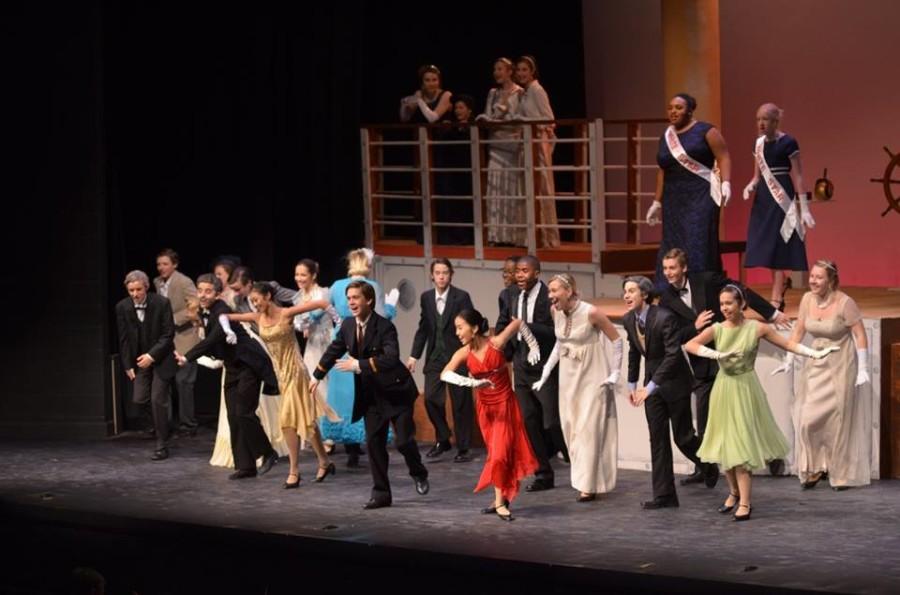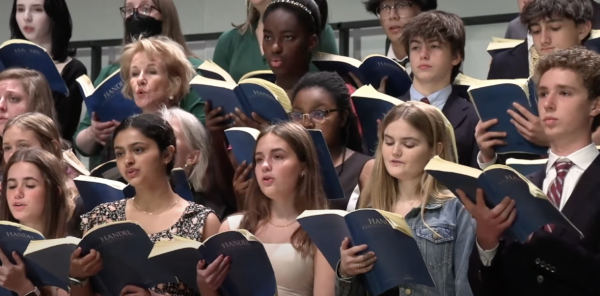Large cast and historical accuracy render Titanic successful
With the largest cast of actors in Westminster history, realistic sound effects, and a boat onstage, this fall’s production of Titanic wowed hundreds during its performances on Oct. 22, 23, and 24. The cast, made up of 65 actors, has been working since Aug. 20 to perfect the show.
The musical follows the tragic maiden voyage of the Royal Mail Ship Titanic as it crossed the Atlantic Ocean but never reached its final destination in New York City, sinking only 400 miles away from dry land. The 1997 movie featuring a fictional love story has no correlation to the musical. Maury Yeston and Peter Stone’s musical, Titanic, includes an array of true stories relating to the ship and its maiden voyage, documenting events from first to third class.
The musical features not only stories of the voyage but also the mentality of those hoping to live the American Dream.
“I really like the song ‘Lady’s Maid,’” said freshman third classcast member Sang-Mi Lee, “where the entire third class sings about their hopes for their future in America.”
Titanic uses a multitude of technical elements and characters to create a medley of stories to depict the voyage of the RMS Titanic. Captain E.J. Smith, architect Thomas Andrews, and owner J. Bruce Ismay toast the technological achievements of the ship in the song “The Largest Moving Object in the World,” as well as during the musical number “What a Remarkable Age This Is” with the rest of the first class passengers.
“One of my favorite things about this musical is that it is mostly historically accurate,” said director Kate Morgens. “The characters are real people who experienced the sinking of the Titanic.”
Almost every character portrayed in the show either has a real life counterpart or strong similarities to someone aboard the historic RMS Titanic. Captain E.J. Smith, played by junior Jimmy Balloun, owner J. Bruce Ismay, played by senior Alex Bean, and architect Thomas Andrews, played by senior Joseph Allan, are three such examples.
The audience can also learn actual facts about RMS Titanic from the lines of the show. Freshmen Lillian Oelkers and Emma Bussey have a short piece in the opening number about loading the Titanic and give many facts about the actual cargo on the ship, from the 7,000 heads of lettuce to the one Renault town carriage motorcar. Also in the opening number, one of the ship’s stokers, Frederick Barrett, played by senior Jake Smith, salutes the Titanic’s “46,000 tons of steel” and its size, 11 stories high and more than 1000 feet in length. To portray the end of the Edwardian era accurately, a team of mothers and a SCAD graduate and costume specialist, Christine Fredericks, ordered period appropriate hats and jewelry, copied hairdos from the time, and crafted old life jackets for the survivors to wear. The large number of people onstage serves as a reminder of the many passengers aboard the actual ship.
“We have a team of faculty members who choose the musical, and we chose this show for a million reasons,” said Morgens. “The music is gorgeous. There are a lot of exciting roles for students; there are more roles than in most shows.”
The musical combines comedy, tragedy, and romance within its plot. The Major, portrayed by junior Ken Roberts, provides comedy and humor in an otherwise somber show, while characters such as Ida and Isidor Straus, played by senior Juliana Freschi and junior Owen Ladner, respectively, contribute romance and drama. The show encompasses dozens of mini-scenes and songs during its two-hour duration.
“My favorite part of the show is in the opening [scene] when my character, the Bellboy, introduces himself to all of the crew members,” said sophomore Katherine Taylor.
Titanic also features technical aspects put together by technical director Hudson Adams, lighting coordinator Stacy Chalmers, and set painter Lisa Balloun, along with a student tech crew composed of juniors Joe Protiva, Omari Matthews, and Ben Barber and sophomores Alana Ducre, Addison Jones, and Ethan Denning. The tech crew has been working hard for the past few weeks to coordinate the ship’s sounds effects as well as operate equipment such as spotlights and microphones.
“All of the technical elements are supersized. The set is large, and the lighting is intense,” said Adams. “The costumes are plentiful and the sound plot is incredibly complex.”
The cast of Titanic had the privilege of performing with a live orchestra composed of both Westminster students and professional musicians. Instrumental music director Scott Stewart conducted, and choral directors Michael Dauterman and Mason Copeland put countless hours into making the show’s complex music a success.
Dance coordinator and choreographer Lee Harper choreographed dances together for three numbers, including “The Latest Rag” and “What a Remarkable Age,” both of which featured over a dozen dancers. There was also a duet by the DaMicos, two professional dancers in Titanic, performed by sophomore Angela Zhang and freshman Christine Luo in the musical number, “No Moon.”
“It’s fun to just be a dancer in Titanic because it’s slightly different than what everyone else’s characters do, and having your own thing to do in the show is really nice,” said Zhang, “Also, ‘The Latest Rag’ is one of the happier songs in Titanic, so it makes a somber show a little more cheerful.”
The musical sparked to life the tragic maritime event of 1912. Westminster’s production of this musical brought together 65 students, some with no previous stage experience and others who frequently participate in theater productions, to tell the story of the ship’s first and last voyage. A challenging musical for most professional theaters, Titanic was a feat for the Westminster Players that succeeded in pleasing the audience and satisfying the players themselves.
“Although the world of a play always feels real when one is acting in it, Titanic has felt especially important to me due to the strong place of importance the real events of Titanic hold in our society a hundred years later,” said senior Alyssa Mulé. “Performing the show each night is particularly inspiring, harrowing, yet also uplifting to me. I know that I have a duty to do justice not only to theater but also to the many innocent people who died on the fatally unlucky night of April 15, 1912.”









